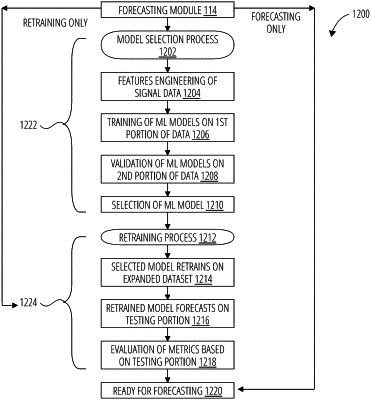| CPC G06Q 30/0205 (2013.01) [G06F 18/211 (2023.01); G06F 18/217 (2023.01); G06F 18/22 (2023.01); G06F 18/251 (2023.01); G06F 18/285 (2023.01); G06N 20/00 (2019.01)] | 24 Claims |

|
1. A computer-implemented method comprising:
engineering, by a processor, one or more features; and
choosing, by the processor, a forecasting method to make a forecast, based on a forecast request;
wherein engineering one or more features comprises:
receiving, by the processor, internal signal data;
receiving, by the processor, external signal data;
fusing, by the processor, data from the internal signal data and the external signal data, the fusing based on meta-data of each of the internal signal data and each of the external signal data;
generating, by the processor, a plurality of features based on one or more valid combinations that match a transformation input, the transformation forming part of a library of transformations; and
selecting, by the processor, one or more features from the plurality of features, based on a predictive strength of each feature, to provide a set of selected features;
and wherein choosing the forecasting method comprises:
training, by the processor, one or more machine learning models, using the set of selected features;
and either:
i) selecting, by the processor, a machine learning model from the one or more machine learning models to make the forecast; or
ii) retraining, by the processor, a previously-selected machine learning model from the one or more machine learning models and using the retrained model to make the forecast; or
iii) making, by the processor, the forecast based on the previously-selected machine learning model.
|